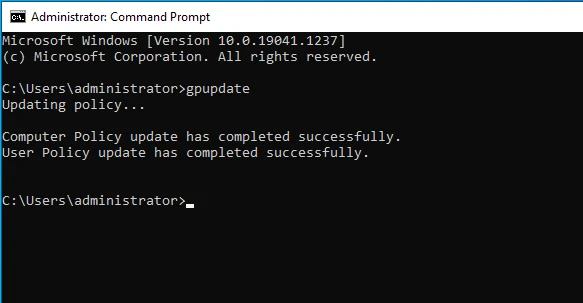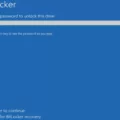If you are an IT professional, chances are you have come across the term ‘gpupdate force’. This command is used to force a Group Policy update on your Windows machines. This can be helpful when troubleshooting or when making changes to the policy settings and wanting to quickly apply them. In this blog post, we will discuss how to use the gpupdate force command and why it’s important.
Group Policies are collections of settings that can be applied to computers in an Active Directory network, such as security settings or software deployment policies. When you make changes to a Group Policy, they usually take effect within 90-120 minutes by default. However, if you want the changes to happen right away or if you need to troubleshoot a policy issue, then it is possible to force a Group Policy update using the gpupdate command.
To use the gpupdate force command, first, open the Start Menu and select Command Prompt or Windows PowerShell from the list of options. Then type in gpupdate /force and press Enter. This will initiate an immediate update of all computer policies that have been changed recently. If you only want to update certain computer policies that have been changed recently, then type in gpupdate /target: computer instead and press Enter.
When running this command, it can be helpful to add some additional parameters for more control over which policies are updated and how long the update process takes. For example, adding the /sync parameter will ensure that all user settings are applied before any computer ones while adding /wait:x will cause it wait x number of minutes before continuing with other operations so that any Group Policy processing time can finish correctly.
using gpupdate force is an important tool for IT professionals who need to troubleshoot policy issues quickly or make sure that their policy changes take effect immediately on their Windows machines. The command is easy to use and provides some useful additional parameters for more control over which policies are updated and how long it takes for them all to finish processing.

Running Gpupdate in Command Prompt
To run the gpupdate command in Command Prompt, first, open the Start Menu and select Command Prompt. Then type ‘gpupdate’ and press Enter. This will update all Group Policy settings on your computer. After running the command, it is recommended to restart your computer for any settings to take effect.
Forcing All Computers to Run GPUpdate
To force all computers to Gpupdate, you must open a Command Prompt window (by searching for cmd in the Windows Start menu). In the Command Prompt window, type gpupdate /target: computer /force and press Enter. This will update all computer policies, regardless of whether or not they have been changed.
How Long Does it Take to Run GPUpdate?
By default, the Group Policy update process takes approximately 90 to 120 minutes. However, if you need the update to take place sooner than this, you can force the GPO update process by using the command line utility “gpupdate”. This will cause the update to occur immediately. Please keep in mind that it is best practice to allow sufficient time for a complete policy refresh before making any changes or modifications to a system.
Frequency of GPUpdate Run
Gpupdate is a tool used to synchronize Group Policy settings for a computer and its users. By default, Gpupdate refreshes policy settings every 90 minutes plus a random offset of up to 30 minutes. This means that the actual time between refreshes can range from 90 minutes to 120 minutes. You can also manually run Gpupdate at any time to force an update of policy settings.
The Functionality of GPUpdate
GPUpdate is a command-line tool that allows administrators to refresh Group Policy settings on local and remote computers in an Active Directory domain. It refreshes both computer and user-based Group Policy settings, including security settings, folder redirection, software installation, scripts, and more. GPUpdate can be used to ensure that the latest Group Policy settings are applied to computers in the domain. It also helps troubleshoot issues with existing Group Policy settings by updating the policy settings on a computer and then checking the results. GPUpdate is often used as part of routine maintenance tasks to keep group policy up-to-date across all computers in the domain.
The Meaning of GPUpdate Force
GPUpdate Force is a command-line tool that enables you to update group policy settings on your local computer or on remote computers. When you use the /Force switch with the GPUpdate command, all Group Policy settings are reapplied, including both computer and user settings, regardless of whether they have changed. This is useful if you want to ensure that all Group Policy settings are applied correctly, without having to manually check for changes.
The Difference Between GPUpdate and GPUpdate Force
GPUpdate is a command line utility used to refresh Group Policy settings on a local or remote computer. It refreshes the settings to ensure any changes made to Group Policy are applied. GPUpdate /force is an advanced version of GPUpdate that forces the application of all policy settings, including those that haven’t changed since the last refresh. This can be useful if there is a problem with applying certain policies, or if you want to ensure that all current policy settings are applied immediately.
Forcing Group Policy Using CMD
To force a Group Policy update in CMD, you need to first open the Command Prompt window. To do this, go to the Start menu and search for either “Command Prompt” or “Command Prompt (Admin)”. Once you have opened the window, run the command “gpupdate /force”. This command will force an update of all Group Policy settings on your computer. After running this command, you should be prompted to either log off or restart your computer. Once you have done this, the Group Policy update will be applied and all changes should take effect.
Does Gpupdate Force Require a Reboot?
No, gpupdate does not always require a reboot. It can be used to refresh Group Policy settings without restarting the computer. However, if a policy change requires it, you can use the /logoff or /boot switch to let gpupdate figure out if a logoff or reboot is necessary. For example, running gpupdate /boot will only cause the computer to reboot if a policy change requires it.
Conclusion
In conclusion, gpupdate /force is a useful command in Windows that allows you to manually force the Group Policy update process. This ensures that all changes in your computer policies are applied immediately, instead of waiting up to two hours for the default process to complete. It should be noted, however, that this command should only be used when necessary as it may cause unexpected results if not used properly.








